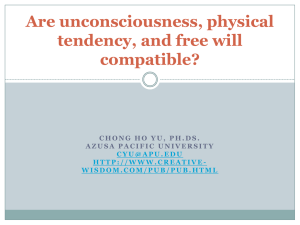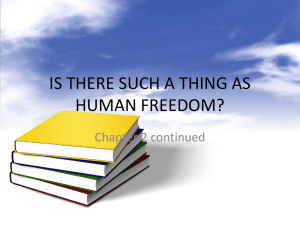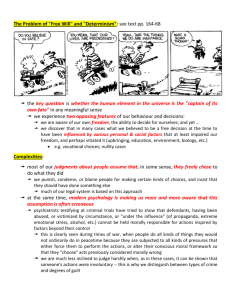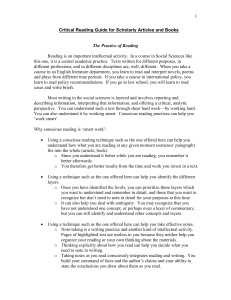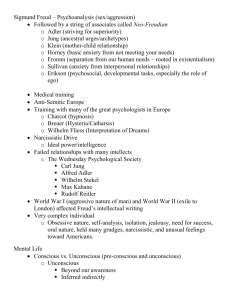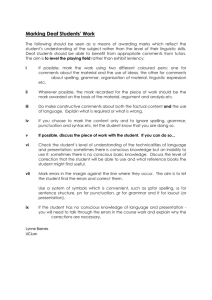Are unconsciousness, physical tendency, and free will compatible
advertisement
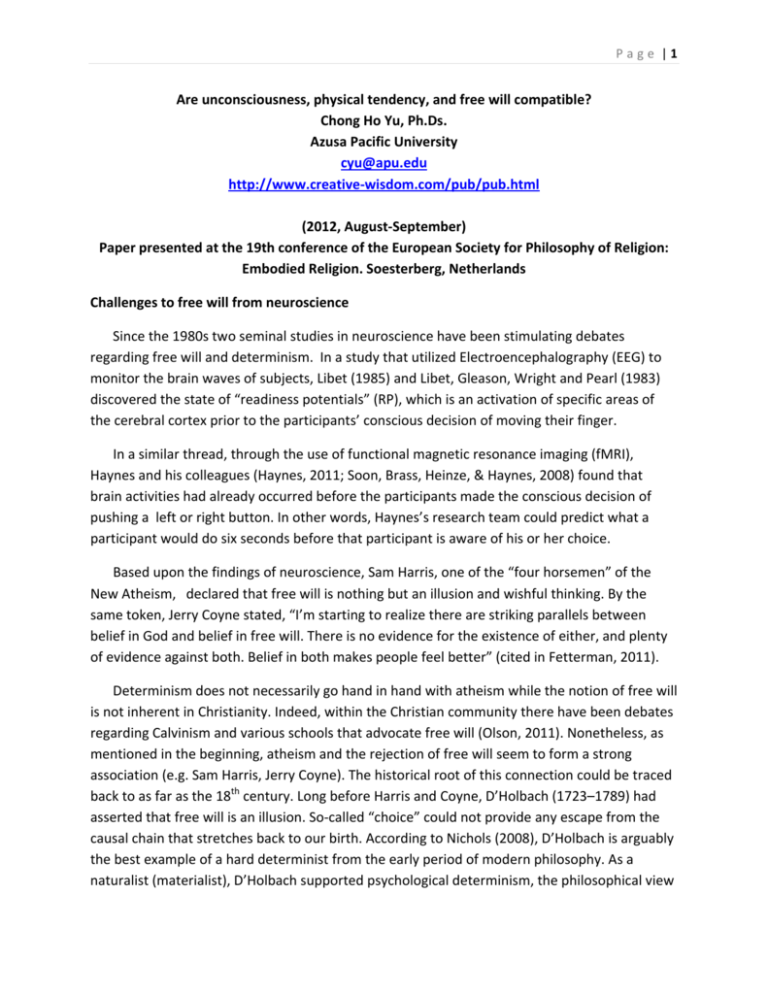
P a g e | 1 Are unconsciousness, physical tendency, and free will compatible? Chong Ho Yu, Ph.Ds. Azusa Pacific University cyu@apu.edu http://www.creative‐wisdom.com/pub/pub.html (2012, August‐September) Paper presented at the 19th conference of the European Society for Philosophy of Religion: Embodied Religion. Soesterberg, Netherlands Challenges to free will from neuroscience Since the 1980s two seminal studies in neuroscience have been stimulating debates regarding free will and determinism. In a study that utilized Electroencephalography (EEG) to monitor the brain waves of subjects, Libet (1985) and Libet, Gleason, Wright and Pearl (1983) discovered the state of “readiness potentials” (RP), which is an activation of specific areas of the cerebral cortex prior to the participants’ conscious decision of moving their finger. In a similar thread, through the use of functional magnetic resonance imaging (fMRI), Haynes and his colleagues (Haynes, 2011; Soon, Brass, Heinze, & Haynes, 2008) found that brain activities had already occurred before the participants made the conscious decision of pushing a left or right button. In other words, Haynes’s research team could predict what a participant would do six seconds before that participant is aware of his or her choice. Based upon the findings of neuroscience, Sam Harris, one of the “four horsemen” of the New Atheism, declared that free will is nothing but an illusion and wishful thinking. By the same token, Jerry Coyne stated, “I’m starting to realize there are striking parallels between belief in God and belief in free will. There is no evidence for the existence of either, and plenty of evidence against both. Belief in both makes people feel better” (cited in Fetterman, 2011). Determinism does not necessarily go hand in hand with atheism while the notion of free will is not inherent in Christianity. Indeed, within the Christian community there have been debates regarding Calvinism and various schools that advocate free will (Olson, 2011). Nonetheless, as mentioned in the beginning, atheism and the rejection of free will seem to form a strong association (e.g. Sam Harris, Jerry Coyne). The historical root of this connection could be traced back to as far as the 18th century. Long before Harris and Coyne, D’Holbach (1723–1789) had asserted that free will is an illusion. So‐called “choice” could not provide any escape from the causal chain that stretches back to our birth. According to Nichols (2008), D’Holbach is arguably the best example of a hard determinist from the early period of modern philosophy. As a naturalist (materialist), D’Holbach supported psychological determinism, the philosophical view P a g e | 2 that all mental processes are determined by prior psychological or physical events. It is his conviction that nature consists of substance and motion only, and thus everything in nature, including the human mind, is subject to and can be explained by physical laws. This “naturalization” of mind is echoed by quite a few modern scholars. The “astounding hypothesis” proposed by Crick (1984) is a typical example: “Your joys and your sorrows, your memories and your ambitions, your sense of personal identity and free will, are in fact no more than the behavior of a vast assembly of nerve cells and their associated molecules. As Lewis Carroll’s Alice might have phrased it: ‘You’re nothing but a pack of neurons.’” (p.3). Additionally, according to Bloom and Weisberg (2007), the “common sense” that the mind is fundamentally different from the brain comes naturally to children. Preschool children accept that the brain is responsible for some aspects of mental life, such as solving math problems. But at the same time they deny that the brain has something to do with loving one’s brother. To Bloom and Weisberg, the mind is simply the brain, and therefore they are resentful that this type of “nonscientific” concept, grounded in common‐sense intuitions, is transmitted by seemingly trustworthy sources. To people who subscribes to the materialistic and natural world view, free will is considered mystical or even supernatural. Nothing can go beyond materials; everything must be explained by physical laws formulated by science. Apparently, the advent of neuroscience provides evidence to support the view that the mind is the brain and free will is illusory. However, the argument based upon the Libet and Haynes experiments has two major logical flaws. First, it assumes that a conscious decision is a necessary condition for free will. If the awareness of the action and the brain activity associated with the action do not happen simultaneously, we are not considered free to choose our action. Second, if our thought is limited by a certain physical disposition, there is no free will either. The counter‐argument given by the author is anchored by the definition of free will derived from classical compatibilism, the view that free will and determinism are fully compatible (Nichols, 2008). According to classical compatibilism, free will is not the opposite of indeterminism, in which nothing can restrict our mind. Rather, free will implies that our minds are free from external coercion only. But the presence of internal compulsion, including our desire and disposition, does not negate free will. Are intentions always conscious? Marcel (2003) wrote, “Many psychologists seem to assume that intentions are by their nature conscious” (p. 60). Bargh and Morsella (2008) call it “conscious‐centric bias” (p.73). They pointed out that until quite recently in the history of science and philosophy, mental life was viewed as mostly conscious in essence. This view is manifested by DesCartes’ cogito (I think therefore I am) and Locke’s “mind first” cosmology. In reality, actions resulting from unconscious thought might precede the conscious mind. In other words, action precedes P a g e | 3 reflection. Similarly, Schlosser (2011) argued that actions yielded from free will are not always consciously initiated. Every conscious event may have unconscious precursors. Mele (2009) illustrated the unconscious mode of intentions by using an everyday example: He goes to his office almost every morning. When he intentionally unlocks his office door, he’s operating in the auto‐pilot mode. He does not need a conscious decision to unlock it. However, if he hears a fight in the office, then he might pause for a moment to decide whether he should continue to keep his door unlocked or leave. Mele (2003) criticized that Libet and his followers confused between urge (wanting, wish, or desire), intention, and decision. In Libet’s experiment, the participants’ physical tendency to move a finger might be considered a desire, but it is not an intention at all. As explained before, there is a subtle difference between intention and decision, and the former does not require full consciousness. In Mele’s view, the readiness potentials discovered by Libet should be treated as an urge, not an intention or a decision. In addition, Mele pointed out that in Libet’s experiment the subjects were told in advance not to move their fingers, but to prepare to move them later. This preparation might have created the so‐called readiness potentials. Interestingly enough, Schlosser (2011) offered a similar counter‐argument: the subjects in Libet’s experiments made a conscious decision to participate in the study and follow the instruction. Schlosser called it “distal intention” because the action following the intention is not immediate. However, the conscious decisions made at the beginning of the study “work their way” (p.369) into the motor control system. Schlosser (2011) argued that most of our decisions have two components: what to do and when to do. The former is more important than the latter because the when‐ decision, which is concerned with how to implement a what‐decision, is made after the what‐ decision. The author of this article would like to use this example: if a woman says “yes” to her boyfriend’s proposal, this is certainly a what‐decision. What happens next is about deciding when the wedding and the honeymoon will take place. In a sense the wedding and the honeymoon are “pre‐determined” by the what‐decision earlier. Following this line of reasoning Libet’s study at best implies that certain when‐decisions are tied to physical dispositions, but not what‐decisions. The history of science is full of examples about how innovations and problem‐solving emerge from unconsciousness. Interestingly enough, many times the scientists made a conscious commitment to solve a particular problem, and this decision “worked its way” into the unconscious side of the mental structure. For example, Kekule found the solution to the problem of the structure of a benzene molecule while watching the dance of fire like a snake in his fireplace. Indeed, the solution did not pop up “suddenly.” Long before the vision at the fireplace, Kekule had seen a gold ring consisting of two intertwined snakes biting their own tails. By citing the example of the benzene ring, Seifert, Meyer, Davidson, Patalano and Yaniv P a g e | 4 (1995) speculated that the final steps on the road to insight may be subconscious; Had the brain of Kekule been scanned by modern medical equipment, we would have observed that before Kekule solved the problem, the image of the snake had already activated certain sections of his brain. However, it is problematic to say that Kekule should not be praised for the discovery because it is “determined” by his brain or the gradual built‐up of the solution is unconscious. The invention of the polymerase chain reaction by molecular biologist Kary Mullis followed a similar path. Mullis said, “The revelation came to me one Friday night in April, 1983, as I gripped the steering wheel of my car and snaked along a moonlit mountain road into northern California’s redwood country” (cited in Auyang, p.3). Again, it is unlikely that the solution emerged “suddenly.” Like the participants in Libet’s experiment, Mullis had decided to conduct research in biotechnology and this distal what‐decision “worked its way” into his cognitive system. But unlike Libet’s subjects, Mullis virtually had no control of the when‐decisions. Rather, certain areas of his brain had definitely been activated to pave the way for the solution. Free will is not free of internal compulsion To a certain extent the study conducted by Haynes and his associates is a more serious challenge to free will than Libet’s study, because the former has no component relating to response readiness, and thus the counter‐argument based on distal what‐decisions and when‐ decisions becomes irrelevant. In Haynes et al.’s experiment, subjects could decide to choose pressing one of two buttons with either the left or the right index finger. However, at most Haynes’s study implies that our decision is confined or influenced by our physical condition of the brain. Haynes could predict a left or right button press with 60% accuracy only. In other words, there is a 40% chance that the subject could override the physical tendency. Indeed it is harder to defend absolute determinism than free will. The probability that X will happen or X will be “chosen” must be 100% in order to call the event “pre‐determined.” However, if there is just 1% probability that X will not happen, it has left sufficient leave room for free will. Consider this hypothetical scenario: There is a country that has been ruled by a dictator for more than half a century. In this nation information is tightly filtered and controlled. As a result, all citizens are brainwashed to unconditionally support the regime. The population of this nation is 10 million, but out of these 10‐million people there is one dissident who dares to promote democracy, liberty, and human rights, and speaks against the regime. One may argue that the majority of these people are “pre‐determined” to be submissive, and they have “no choice.” But as long as there is just 1 out of million probability that one could choose otherwise, free will prevails. In probability and statistics there are many different forms of distributions, such as chi‐square distribution, t‐distribution, F‐distribution, and Poisson distribution. In short, every event has a distribution and even extreme cases (outliers). Uniform outcomes across all the members in a sample or a population are not P a g e | 5 realistic. Naturalists or materialists maintain that everything is subject to natural or physical laws. Following this line of reasoning, probability and statistical laws, which tell us that not everyone has exactly the same response or action, are also part of natural law. Haynes demonstrated that our will or mind has a physical basis, and this notion is fully compatible with the philosophy of “embodied mind” (Lakoff & Johnson, 1999). In other words, free will should not be equated with the absence of any constraints or influences, including our bodily constraints. Simply put, the notion of embodied mind rejects the mind‐body dualism that has been prevalent in the Western culture for several centuries, and faculty psychology that has been misguiding psychologists for a century. Lakoff and Johnson (1999) wrote, “The architecture of your brain’s neural network determines what concepts you have and hence the kind of reasoning you can do” (p.16). In this view, our perception is equated with our conceptualization, and vice versa. Take our concept of colors as an example. The perception of color is based on human internal neural structures and the external physical conditions (e.g. wavelength). We perceive that a banana is yellow even under different lighting conditions. Actually, this color consistency results from our brain’s ability to compensate for variations in the light source. As a photographer, this author is well‐aware of the interactive nature of our perception. If we take an indoor photo under fluorescent bulbs without a flash unit, the picture will be flooded with green light. There is nothing wrong with your camera. In fact, the camera sensor and lens capture the exact lighting. In a room we “see” white light instead of green because our brain makes compensation for the “incorrect” color. In short, our color concepts have a strong physical base. Although the theory of embodied mind did not arise from the context of the free will‐determinism debate, it is still highly relevant in the sense that our mind or our will is never independent from our physical configuration. But does it mean that we are not free? It depends on how we define free will. One of the classical definitions of free will is that it requires the absence of constraint (coercion and interference). But this definition does not specify whether the source of coercion and interference is internal or external. If my action is caused by external compulsion, I have no free will. For example, if I am a slave my labor is not freely chosen. But what if I am an alcoholic who is driven by my internal urge to do binge drinking? Did I lose my free will? Am I still responsible for my obsession? The same question can be asked about drug addicts, compulsive gamblers, and even psycho‐killers. By common sense we might say, “They are still responsible for what they did in spite of their internal compulsion or physical disposition though they may not be fully responsible.” Yamada (personal communication) went even further to assert that “free will has more to do with the ability to overcome or nullify constraints and to institute and enforce new constraints, than it does with the absence of constraints.” When the author talked P a g e | 6 to several recovered or recovering gamblers during a short term mission trip in Panama, it was observed that very often many gamblers and ex‐gamblers go back and forth between the old and new life styles. The most effective way to overcome obsession is not trying to free oneself from the constraint by will alone. Rather, the person must build a new healthy habit as a replacement of the old one. In short, exercising free will is making self‐imposing constraints, a new type of internal compulsion. You make habits and habits make you! Hence, free will might not be as dichotomous as most people thought (either your choice is totally free or your behaviors are totally determined). Rather, it should be viewed as a continuum between two polarities. In Haynes experiments on the average there is a 40% chance that you could do otherwise, but there is a distribution or within‐group variance. Some people might have a high degree of internal compulsion and some may have a weaker one. In the perspective of within‐subject distribution and free will/determinism being a part of a continuum, perhaps free will and determinism are compatible. Discussion In summary, if we do not confine free will to conscious decisions and extend free will to boundless freedom without any internal disposition and compulsion, then it seems that Libet’s and Haynes’ studies cannot decisively negate the existence of free will. Nonetheless, by recognizing that our mind is embodied and our will is influenced by the neural structures, free will and determinism are better construed as a continuum instead of a dichotomy. The challenge to free will introduced by Libet and Haynes is not new. Its scientific root can be traced back to as early as the 17th century. Based on Newtonian physics, French scientist Laplace claimed that everything in the universe is determined by physical laws. If there is an intellectually powerful being (called Laplace's demon) that can fully comprehends Newtonian law, and knows the position and momentum of every particle in the universe, then he could definitely predict every event in history. Originally Laplace's determinism was applied to the realm of extended, spatial, material substance only. Later this type of determinism was expanded to the realm of psychological events. Under determinism, there is only one necessary outcome in the causal chain (Hacking, 1992). Today determinism and this type of alleged predictive power switch the foundation from physics to neuroscience. However, later the probabilistic worldview of quantum mechanics overshadows the Laplace demon. According to quantum mechanics, there are infinite possible universes. Physicists found that in the subatomic world, events are not the inevitable and unique solution to single‐valued differential equations, but are the random expression of a probability distribution. The present state limits the probability of future outcomes, but does not determine a definite fixed result (Weatherford, 1991). Heisenberg’s uncertainty principle shows us that we cannot measure the P a g e | 7 position and the momentum of a particle at the same time, and thus Laplace’s demon is physically impossible. Laplace’s view emerged at the dawn of modern physics (Newtonian mechanics) and needless to say, his assertion was premature and over‐simplistic. Bluntly speaking, neuroscience is a fairly new discipline, and after all, Libet and Haynes only studied a very simple form of awareness and decision‐making: moving the finger. However, if someday neuroscientists could predict whether a college graduate would continue on to graduate study or which stock an investor would buy, then we would have to take a fresh look into this area of study. For now any bold statements or strong inferences out of these experiments should be interpreted with caution. Acknowledgments Special thanks to Dr. Walter Yamada and Mr. Craig Jentick for their valuable input to this article. References Auyang, S. (2012). Chance and the prepared mind in drug discovery. Retrieved from http://www.creatingtechnology.org/biomed/chance.pdf Bargh, J. A., & Morsella, E. (2008). The unconscious mind. Perspectives on Psychological Science, 3, 73‐79. Bloom, P., & Weisberg, D. S. (2007). Childhood origins of adult resistance to science. Science, 316, 996‐997. Crick, F. (1994). The astonishing hypothesis: The scientific search for the soul. New York, N.Y.: Scribner and Sons. Fetterman, A. K. (2011). Free will is the new god. Social Psychology Eye. Retrieved from http://socialpsychologyeye.wordpress.com/2011/06/14/free‐will‐is‐the‐new‐god/ Harris, S. (2012). Free will. New York, NY: Free Press. Lakoff, G., & Johnson, M. (1999). Philosophy in the flesh: The embodied mind and its challenge to western thought. New York, NY: Basic Books. Libet, B. (1985). Unconscious cerebral initiative and the role of conscious will in voluntary action. Behavioral Brain Science, 8, 529–566. Libet, B., Gleason, C. A., Wright, E. W., & Pearl, D. K. (1983). Time of conscious intention to act in relation to onset of cerebral activity (readiness‐potential): The unconscious initiation of a freely voluntary act. Brain, 106, 623–642. Hacking, I. (1992). The taming of chance. Cambridge, UK: Cambridge University Press. Haynes, J. D. (2011). Decoding and predicting intentions. Annals of the New York Academy of Sciences, 1224, 9‐21. doi: 10.1111/j.1749‐6632.2011.05994.x Marcel, A. (2003). The sense of agency: Awareness and ownership of action.” In J. Roessler and N. Eilan, eds., Agency and Self‐Awareness. Oxford: Clarendon Press. Mele, Alfred R. (2009‐04‐22). Effective Intentions: The Power of Conscious Will (p. 168). Oxford P a g e | 8 University Press. Kindle Edition. Mele, A. R. (2006). Free will and luck. Oxford: Oxford University Press. Mele, A. R. (2009). Effective intentions: The power of conscious will. Oxford: Oxford University Press. Nichols, S. (2008). Great philosophical debates: Free will and determinism. Chantilly, VA: Teaching company. Olson, R. (2011). Against Calvinism. Grand Rapids, MI: Zondervan Schlosser, M. E. (2011). Free will and the unconscious precursors of choice. Philosophical Psychology, 25, 365‐384. Seifert, C. M., Meyer, D. E., Davidson, N., Patalano, A. L., & Yaniv, I. (1995). Demystification of cognitive insight: Opportunistic assimilation and the prepared‐mind perspective. In R. J. Sternberg, & J. E. Davidson (Eds), The nature of insight (pp. 65‐124). Cambridge, MA: MIT Press. Soon, C. S., Brass, M., Heinze, H. J., & Haynes, J. D. (2008). Unconscious determinants of free decisions in the human brain. Nature Neuroscience, 11, 543–545. Weatherford, R. (1991). The implications of determinism. New York, NY: Routledge.
